Of Old Radios And Related Items--Published Monthly
Military "PBS" -- Vintage 1942
Designing a Post Broadcasting System
BY DOROTHY SCHECTER FROM INFORMATION
CONTRIBUTED BY EDWARD SCRIBNER
Web Edition
In the May 2004 issue of A.R.C., Edward Scribner responded to our August 2003 cover depicting salvaged radios slated to aid in the war effort. He not only had first-hand experience with those salvaged radios, but also became the designer of the one-of-a-kind military wired "broadcasting" system described in this article. (Editor)
At age 96, Ed Scribner, shown in Figure 1 at the control panel of his custom-built sound system, is still a "Radio Man" par excellence. Only last summer, he was called upon to repair the PA system that had been damaged by lightning at the 125-year-old Upstate New York Cobleskill "Sunshine" Fair and Race Track shortly before the Saturday night races were to begin. An engineer in the electrical and electronics business since October 1925, Ed Scribner was obviously the man to call in this local crisis.
After all, he installed the first audio system at the fair in 1927, and though officially retired, he continues to help his successor Ron Trask make improvements in the system. Scribner was the subject of a feature story in the September 2004 issue of Systems Contractor, a trade publication for the sound industry. The article describes the complexities in delivering sound to the 40-acre fairground where more than 100 loudspeakers can be individually converted into an intercom. The system even allows the operator to talk back to people on the speakers. This is what Trask calls "another Ed-designed feature."
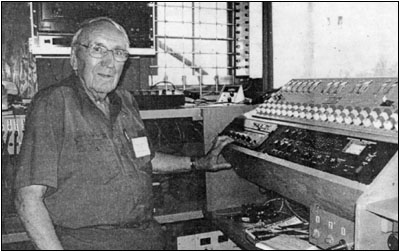
Figure 1. Ed Scribner today at his custom-built control board which is part of the complex PA system that delivers sound to the Cobleskill Sunshine Fair in Upstate New York every year.Scribner's technical reputation had a fairly recent moment in the spotlight of the Late Show with David Letterman. Letterman had invited 500 people from the tiny town of Schoharie to see the show. When he asked what the other 492 people who stayed home were doing, someone shouted a response, "Watching Ed Scribner wire up a toaster."
Scribner is also credited with what some historians call the world's first outdoor showing of a talking motion picture. He had converted a 1917 movie projector for sound and used it to show weekly feature films in the village on summer evenings from 1930 to 1942.
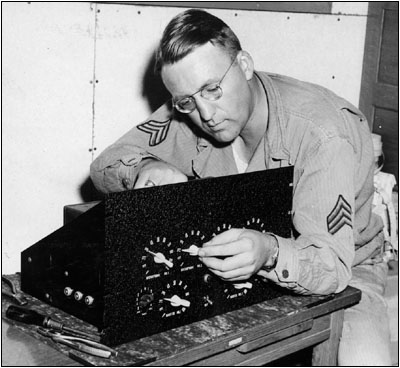
Figure 2. In this photograph, then Sergeant Scribner is shown putting the finishing touches on an amplifier that he built for use in the Post Broadcasting System.Back in 1942, Scribner's talents also came to be appreciated by the Army Air Force, though he had been rejected for service earlier because of poor eyesight. However, with a waiver on eyes because of his technical knowledge, and perhaps by dropping the name of longtime friend Colonel John F. "Jack" Rider (yes, the John F. Rider of radio reference fame), he was ultimately accepted as a noncombatant. This classification meant no basic training and no overseas service.
Instead, he was ordered immediately to the Radio Training School in Souix Falls, South Dakota, to which he traveled on his own, also paying for his own rail ticket. A sobering thought was that he didn't even have identification papers and might have ended up in the stockade had an MP stopped him along the way. Nevertheless, he concluded that "someone knew something about me" because he was given a permanent pass the day after arrival. Right away, he became part of the huge task of supplying radio parts to instructors for use in training their thousands of students.
"PBS" or the Post Broadcasting System
From the beginning, the higher-ups must have had something more in mind for this unusual 34-year old recruit. Though only a private, he was called to attend a meeting with school officers to discuss ways of alleviating the trainees' boredom when listening to code with earphones for long hours. Understandably, the students were getting groggy and nodding off. The first solution was to buy a turntable and an amplifier to play popular recordings, plus a microphone for announcements. After a trip downtown with an officer to buy the equipment, Scribner was to hook it up in the room adjoining the code room where students trained.
The new unit was an RCA broadcast quality transcription turntable with playback and recording capability. The unit could handle 16-inch records at speeds of 331/3 rpm or 78-rpm. A dozen or more units were installed in Post Headquarters in about three days. Scribner handled the mechanics of operating the system to feed music and news to the four code classes on two shifts that soon expanded to three.
Among the difficulties was getting announcers from the student body and dealing with the noise factor from adjoining rooms. In this regard, he and the base Chief Executive Officer spent two days looking among several hundred buildings for a reasonably quiet space, but to no avail.
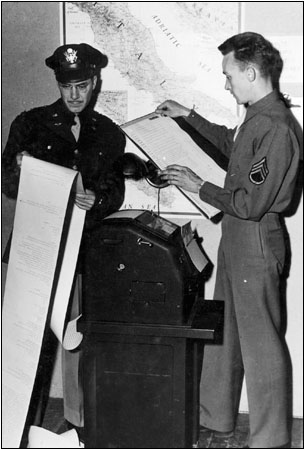
Figure 3. The Associated Press teletype printer provided the latest news for "broadcast" over the Post Broadcasting System.During these first months of service, Scribner bypassed Private First Class rating and became a Corporal. Before leaving on his first furlough in April 1943, the CO handed him his Sergeant's stripes and told him to come to see him on his return. He had been in the service for only six months!
Expanding PBS
On his return from furlough, Scribner reported to the CO, now a Lt. Colonel, who had come up with another job for him. A critical problem was getting students to the school sessions and duty posts on time. Sometimes the next shift was 15 to 20 minutes late; sometimes they waited in rain and snow because they were too early. Bugle calls were not exact enough for school sessions, Mess, PT, etc. This, after all, was wartime and every minute counted!
The Colonel wanted Scribner to draw up a plan for each of the 16 squadrons to be equipped with microphone, amplifier, and turntable to play the bugle calls loud enough to be heard from one end of the squadron street to the other. Scribner soon saw that such a multigroup plan would not guarantee the accuracy of timing the sounding of the bugle calls. He determined that the one answer was to design a single control for the entire field. It would be the responsibility of one person or group to play the bugle calls as scheduled, and all would be on time.
The Colonel readily agreed and began the search for space needed to house the equipment, which he ordered Scribner to list and locate in four days. This was no small task, but by the fourth day, Scribner was able to provide a purchase order for 90 percent of the items needed. Meanwhile, the Colonel had found a set of empty barracks made in sections that could be moved and reconstructed for the required space, which would also be shared by the Chaplain, Special Services, and Public Relations
In an appearance before the base staff, Scribner explained how the system would work. It would correlate to the student "breaks" in the Code room, serve multiple functions, such as announcing special changes on the base, the uniform of the day, lost and found items, etc., as well as provide news and entertainment. The base staff approved the program, and Scribner began to design the system.
Figure 2 shows Sgt. Scribner assembling an amplifier for the Post sound system, which included a control console and the room to house it, a large studio linked to the control room by a double-pane glass window, a front office, a workshop, and cabinets for the amplifiers, teletype, etc. The teletype printer shown in Figure 3 provided up-to-date news for "broadcast" over the system.
Identification indicating that the broadcast was coming from the air base was necessary. "Post Broadcasting System" or "PBS" was chosen, and before long, "This broadcast is coming to you from PBS the Broadcasting System of the Sioux Falls Army Air Force" was heard thoughout the base.
By September 1943, PBS had a staff of announcers, script writers, programmers, and technicians and was ready for its first broadcast. Gradually, the system grew to a 22-hour operation, as more and more wires were strung to new locations deemed to be worthy of being a part of the PBS network. For example, a much smaller duplicate of the system, called "PBS Jr." was constructed for the base hospital where speakers were wired into each room.
As development was underway, Scribner learned that a Nebraska contractor had a sound system to sell. It had fifteen horn type loudspeakers, a similar number of amplifiers, a turntable, a microphone, and an AM/FM radio. A bid of one-third the price of new equipment won the day. A truck set off to Nebraska to pick up the bargain items which proved to be hardly used and exactly right for the PBS job.
The Technical Setup
PBS was essentially a huge public address system which was adapted for distributing programs to KSOO and KELO, NBC outlets in Sioux Falls, through telephone lines. The manager of both these stations praised PBS as a "complete broadcast service, except it transmits programs by wire instead of by wireless." NBC had no objections to rebroadcasts because the service was conducted exclusively for Army personnel.
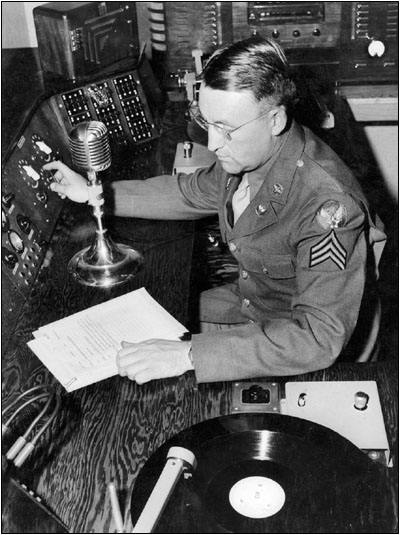
Figure 4. This photograph of Scribner at the PBS control panel provides some details of the equipment. The control panel is custom-built, the Shure microphone and the RCA transcription turntable are typical commercial items of the period. Other commercial items include an intercom, upper left, and an RCA BC/SW receiver, top.Visitors to the PBS studio were impressed with its professional appearance. The control room contained the main console which measured 50" x 90" x 40". In this console were two Stromberg-Carlson preamplifiers, two RCA 16-inch transcription turntables with an RCA recording unit, which facilitated recording and playback at 78 rpm or 33 1/3 rpm, and a monitor amplifier. A recording amplifier with meters indicated volume levels of both recordings and programs going over the air. Figure 4 show Scribner at the control console, and Figure 5 shows him cueing a record on the RCA turntable.
Patchcords made it possible to pick up programs from either of the two amplifiers, the office of the Commanding Officer, both post theaters, the chapel, and the sports arena. Four steel cabinets housed twenty 25-watt Stromberg-Carlson dual channel amplifiers which fed programs to 36 giant loudspeakers distributed in centralized street locations of each squadron and the radio school area. In addition, each mess hall was equipped with four 12-inch Stromberg-Carlson speakers, so the soldiers could have music while dining.
Switch panels facilitated feeding any group of amplifiers to either of three input channels and also feeding any speaker or group of speakers any one of three available programs simultaneously. Each set of speakers could be controlled independently.
The studio consisted of the main studio, the control room, the chief's office and a general office, all of which were thoroughly sound-proofed. The main 20' by 40' studio contained a piano with a Solo-Vox attachment, music stands for an orchestra, many microphones, and an announcer's table and monitoring speaker.
According to a 1945 base publication, Radio News, the most appealing aspect of the PBS system was its "GI personality" -- the system from start to finish is a result of the ingenuity and work of soldiers." Full credit is given in the article to Sgt. Ed Scribner who designed the system and, along with two assistants, installed it, working long hours and giving up much free time.
Programming.
At least seven to twelve programs a week were originated in either the main studio or a Service Club and broadcast over the two radio stations in Sioux Falls, KELO and KSOO, which were very generous in their cooperation. A teletype allowed the acquisition of national and world news simultaneously with any newspaper or other radio station.
Many "big name" bands visited the base and these programs were broadcast nation-wide from PBS. In February of 1945, the Royal Air Force Band and Symphony Orchestra of London, England, with 100 pieces toured the United States. It was said that the only nation-wide broadcast they made during that tour was from the Sioux Falls base equipment. Needless to say, because of the size of the group, one of the base theaters had to be used for a studio.
In keeping with the original intent of the system, each shift of code classes received special 10-minute programs of music and news piped through headsets in classrooms. These programs helped to alleviate the monotony of receiving code and kept the soldiers informed about world events.
Outstanding network shows such as the Bob Hope Show, the Telephone Hour, and Glenn Miller's Army Air Forces Training Command Band were piped in and also transcribed for rebroadcast for those who missed the original. Programs featuring talented soldier singers and instrumentalists, as well as novelty shows and humorous skits, also were aired regularly in the mess halls. On Sundays, organ music, choral works, and short sermons were broadcast from one of three chapels.
Goal Achieved
For two years PBS played a significant role in advancing the rating of the school at Sioux Falls and thereby helping to win the war as soon as possible. A marked improvement in the time required both in the code classes and the radio-technical classes had a direct effect on the efficiency of the entire base operation. As many as 60 bugle calls went out over speakers in a 24-hour period. Announcements covered everything from the time, to dress codes, changes in schedules, lost and found items, and upcoming entertainment.
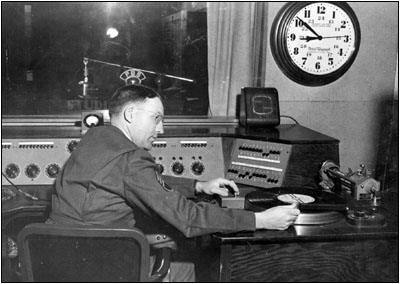
Figure 5. Another view of the control panel shows Scribner, now a Staff Sergeant, cuing a record on the RCA turntable.An interesting point that Ed Scribner makes about the system is that it was built around products that had been on the market for some years, not the electronics that played such an important part in communications during World War II with new warfare items. Instead, PBS was built on "the ingenuity of doing with what you had, and making what you could find do what you wanted it to do."
Epilogue
In the summer of 1945, troops were returning to the states for deployment, and the Souix Falls base became a deployment center. More loudspeakers and microphones were needed to keep the flow of men through the lines. But the radio schools were closing, and the PBS staff was gradually departing. Ed Scribner himself was surprised by sudden orders to report to Fort Dix on October 1, 1945, for discharge. Though he wanted to say goodbye to his many friends at the studio, he found that all but one had already been transferred late the same day or during the night.
He didn't want to leave the studio that had been his home for three years, but almost overnight, he was on his way home to restart the electrical and sound system business that he ran until his retirement in 1980. The experience he took with him from the Sioux Falls PBS "could never have been bought at any price."
References:
Cudmore, Dana. "Schoharie's Ed Scribner Remains an Institution of Sound." Hudson, New York: The Mountain Eagle, n.d.
Minoff, Philip, Cpl. "Sioux Falls." Radio News, May, 1944.
Nelson, Kirsten. "An American Institution." New York: Systems Contractor News, September 2003.
"Post Broadcasting System Begins 24-Hour Service." Sioux Falls, N. D.: The Polar Tech, October 1, 1943.
Scribner, Edward. "The Original PBS." Sound and Communications, February 1991.
(Dorothy Schecter, c/o A.R.C., P.O. Box 2, Carlisle, MA 01741. Edward M. Scribner, P.O. Box 279, Schoharie, NY 12157-0279)
| [Free Sample] [Books, etc., For Sale] [Subscribe to A.R.C./Renew] [Classified Ads] [Auction Prices] [Event Calendar] [Links] [Home] [Issue Archives] [Book Reviews] [Subscription Information] [A.R.C. FAQ] URL = http://www.antiqueradio.com/Mar05_Schecter_PBS.html Copyright © 1996-2005 by John V. Terrey - For personal use only. Last revised: February 27, 2005. For Customer Assistance please contact ARC@antiqueradio.com or call (866) 371-0512 Pages designed/maintained by Wayward Fluffy Publications
Antique Radio Classified |